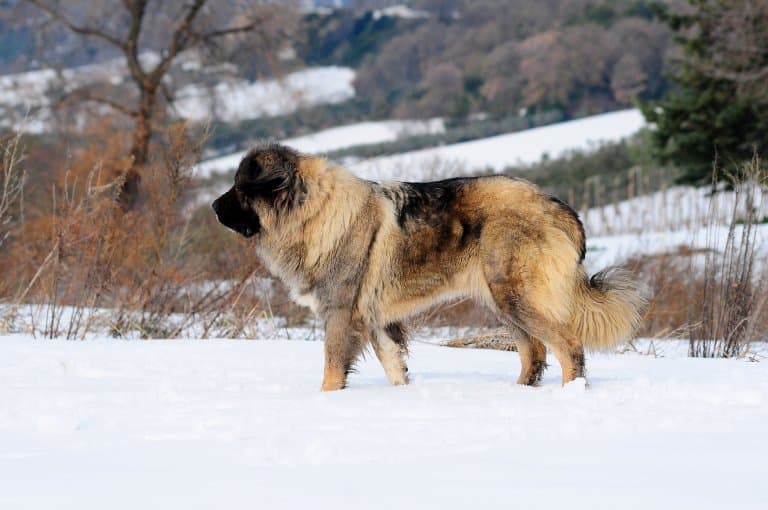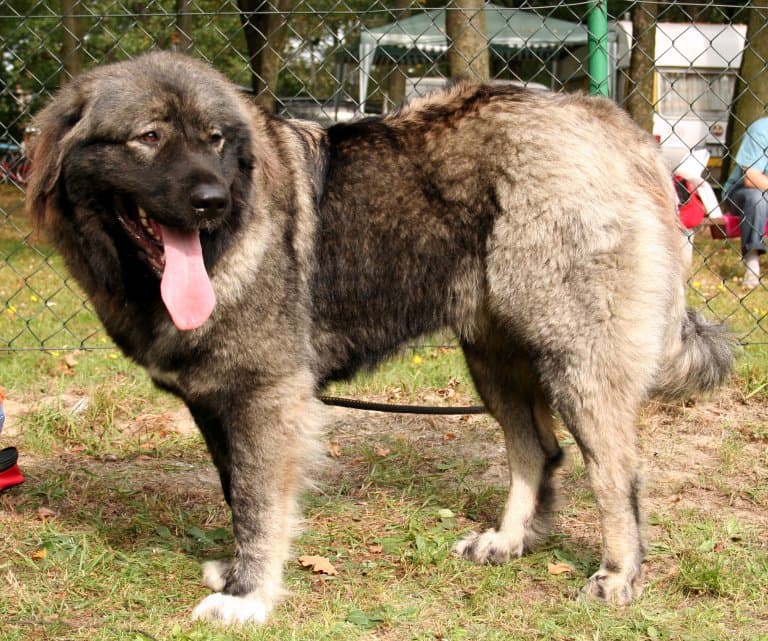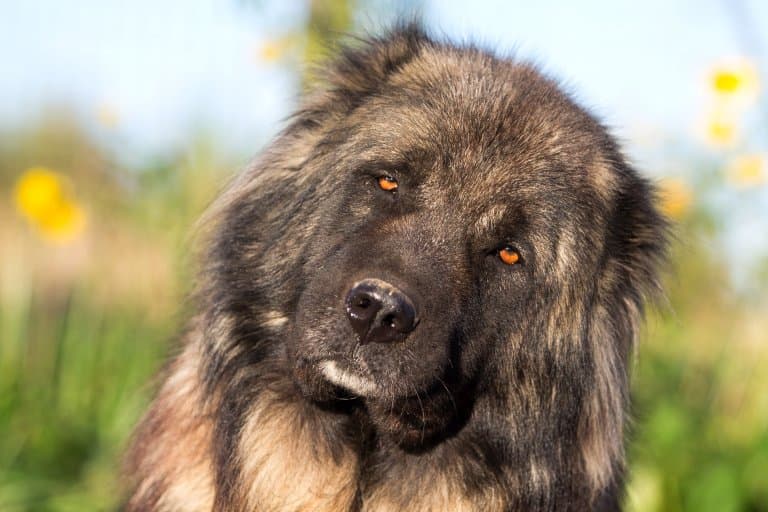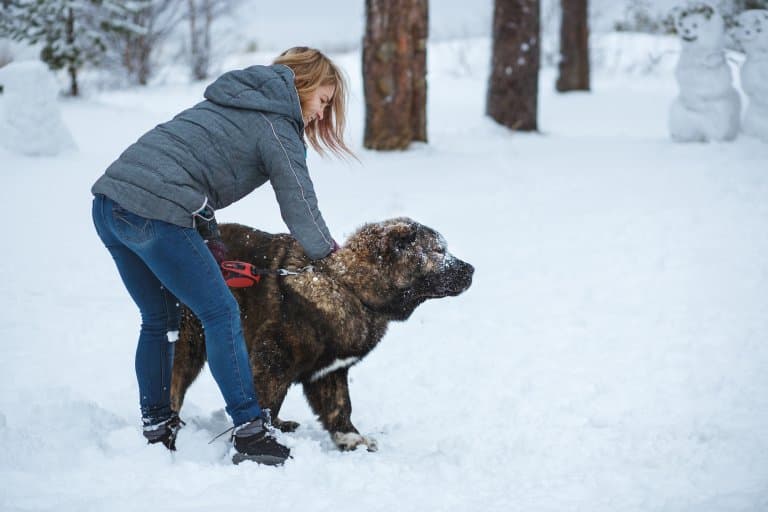Russian Bear Dog Profile
The Russian bear dog, or canis lupus, is also known as the Caucasian shepherd. They are a giant dog breed that has existed for centuries as working dogs in the Cauacasus mountain regions of Russia and Eurasia.
These animals were bred to be livestock guardian dogs, protecting sheep and other livestock from wolves, bears, jackals, and also human thieves.
Their breeding helps to protect them from their large opponents, as well as to withstand unforgiving and extreme conditions – as the area which they come from is notorious for its harsh winters.

Russian Bear Dog Facts Overview
| Habitat: | Bred for use in farms and domestic homes |
| Location: | Eurasia |
| Lifespan: | 10 to 12 years |
| Size: | 23-30 inches (h) |
| Weight: | Between 100 – 170 pounds |
| Color: | Usually white, black, brindle, fawn or grey |
| Diet: | Omnivore |
| Predators: | No natural predators, bred for protection from large carnivores, eg wolves and bears |
| No. of Species: | 1 |
| Conservation Status: | No concern |
Russian bear dogs are very large, hairy shepherd dogs: reaching 72cm in height and 70kg in weight. The male bear dogs are bigger and have larger heads than the females of the species. They have blunt, bear-like faces with short muzzles, highly prominent canine teeth, and deep-set, oval eyes.
Russian bear dogs are commonly a blend of three colors – often black, white, and brindle – but their coloring can also include fawn, grey, cream, and brown. It is very rare to see a Russian bear dog of solid color.
They have a very thick, waterproof double coat which was bred to withstand freezing temperatures. This double-layered coat consists of tough and wiry, coarse outer hair and a thick, fluffy undercoat, which provides vital insulation in the harsh winters.
Their huge paws have hair growing between the toes for the same reason, and their ears are also covered in insulating fur. 1
Despite their giant size, Russian bear dogs are agile and steady on their feet, with good coordination and stability. They also have excellent sight and hearing.
They are highly protective animals in both domestic and working conditions and will fiercely defend their home, and any other animals or humans living alongside them. This can mean that they are somewhat tough to manage as domestic pets; they are difficult to train, stubborn, and have poor recall. They require plenty of early socialization and training from experienced handlers.
They also need plenty of secure, outdoor space, as they are really outdoor animals and require space to roam.
When they feel threatened or stressed, Russian bear dogs are known for their exceptionally loud and threatening bark and intimidating behaviours, including pacing, growling and loud noises.
The Russian bear dog is on a list of potentially dangerous dog breeds compiled by Russia’s Interior Ministry. It is prohibited to walk them without a muzzle and a leash, with the exception of cases when the dog is in the fenced area legally owned by the animal’s owner. 2
Interesting Russian Bear Dog Facts
1. The bite of a Russian bear dog is stronger than a lion’s
Russian bear dogs were bred to protect livestock from fierce predators and their exceptionally strong jaws can exert even more pressure than the king of the jungle! 3

2. Russian bear dogs would typically have their ears cropped
This was originally to prevent predators from grabbing or biting these huge dogs’ ears. However, these days it is generally considered an unnecessary mutilation to crop the bear dog’s ears close to their heads. 4
3. Breeding of Russian bear dogs began during the 1920s
During the 1920s in the USSR, breeding of Russian bear dogs really took off. This was because of their imposing appearance and fearless nature, as well as a reputation for being fierce protectors. It wasn’t until later in the 1930s that Russian bear dogs were seen in Western Europe. They were added to the American Kennel Club’s list of stock breeds in 1996. 5
4. These dogs are instinctive protectors
Bred to protect and defend their flock, Russian bear dogs have very powerful defensive urges and can become unmanageable as pets if they are not properly trained and socialised.
5. In long-haired breeds, the males have a distinctive ‘mane’.
Seen in several breeds of long-haired shepherds, the male Russian bear dogs will often present with a shaggy and pronounced mane around the neck and shoulders, which you would not see on the females of the breed.

6. These giant dogs are now commonly used as prison dogs in Russia
Perhaps unsurprisingly, the combination of their fearless and protective natures, imposing size and stature, and ability to withstand extreme temperatures and weather has meant that these former bear and wolf-hunting dogs are now used as prison guard dogs in many parts of Russia.
7. The nickname of Russian bear dog comes from a past of hunting bears
Early Caucasian shepherds were used in bear hunts, which is what led to their nickname of ‘bear dogs’. Their giant size and fearless, protective nature means that they are not afraid to attack much larger animals to protect their humans. 6

8. Human use of these dogs dates back many centuries
In fact, Caucasian shepherds are documented as far back as 2,500 years ago, where they were created to work on farms and to protect livestock and families from large predators in harsh and isolated conditions. 7
Russian Bear Dog Fact-File Summary
Scientific Classification
| Kingdom | Animalia |
| Phylum | Chordata |
| Class | Mammalia |
| Order | Carnivora |
| Family | Canidae |
| Genus | Canis |
| Scientific Name | Canis Lupus |
Fact Sources & References
- “Caucasian Shepherd Dog”, American Kennel Club.
- “Russia’s Interior Ministry compiles list of potentially dangerous dog breeds“, TRNA.
- Thomas Woods (2022), “Russian Bear Dog Size, Price, Lifespan & More”, Perfect Dog Breeds.
- “Caucasian Shepherd Rescue”, German Shepherd Rescue.
- Anna Samsonova (2010), “KAVKAZSKAÏA OVTCHARKA (Caucasian Shepherd Dog)”, USSR.
- Kaitlyn Arford, “Caucasian Shepherd Dog”, PetMD.
- “8 Russian Dog Breeds”, Purina.
